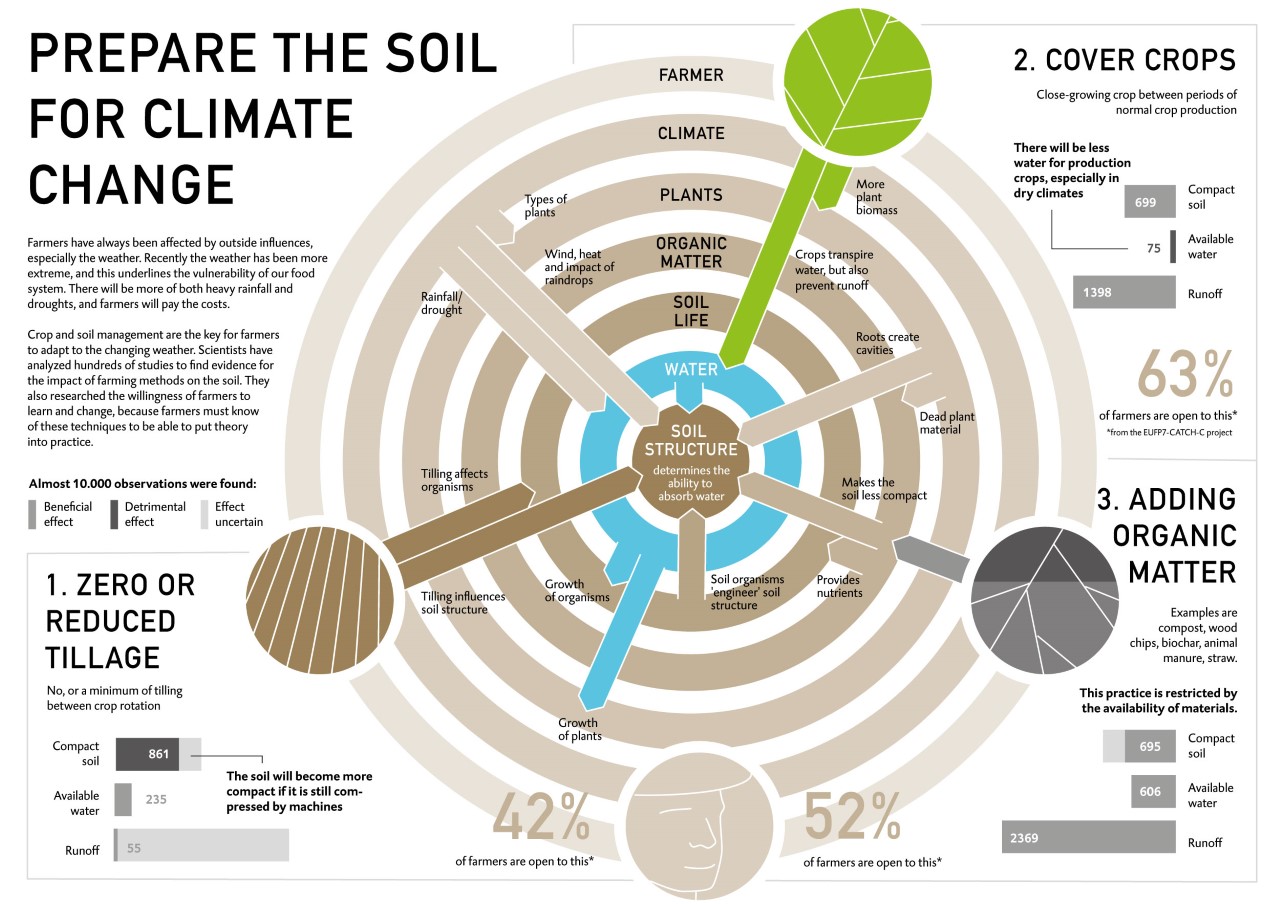
Soil management and cropping systems enhancing soil structure are key to support the sustainable adaptation of EU agriculture to climate change. The occurrence of extreme weather events, such as drought in summer and floods in winter, will increase almost everywhere in the EU. Guidance on management practices and co-learning opportunities to help farmers adapt to these situations are necessary. Many practices exist and have already been subject to scientific research for several decades. Nevertheless, it is not always clear which practices have really proven effective in which contexts, what trade-offs have to be taken into account and which synergies might occur.
ClimaSoMa investigated the implications of agricultural management practices for soil hydrological functioning under European agro-environmental conditions. We synthesized the results of 36 selected meta-analyses (representing data from 2803 unique studies) studying the impact of soil and crop management practices on soil hydrological functioning. As such, we identified the effectiveness of the selected practices, and also remaining knowledge gaps. Important trade-offs and synergies related to crop production, water quality, and greenhouse gas emissions were also assessed based on the results of additional published meta-analyses. The results of this second order meta-analysis are described in Soil and crop management for climate-smart soils .
In parallel, we identified and summarized the socio-economic & political barriers experienced by farmers and incentives for the application of soil and crop management in climate adaptation strategies. We present the results of a stock-take of EU policies and their instruments impacting agricultural management in EU policy instruments driving soil management in view of climate adaptation . Barriers & drivers at the farm level in relation to improving soil health and climate change adaptation are discussed in Farmer engagement as key to successful climate adaptation . The work includes perceptions of barriers and drivers that co-determine the willingness of farmers to act and adapt to climate change.
Human-induced climate change is expected to continue altering climate drivers (e.g., air temperature and precipitation) and enhancing CO2 concentration in the atmosphere, also in the near-future. Changes in these conditions will alter soil processes and affect soil physical (e.g., water availability), chemical (e.g., SOM) and biological (e.g., microbial community and enzyme activity) functioning. It is therefore not only important to understand how our own actions and practices affect soil functioning, but also what is the direct impact of the changing climate. Untangling the effect of climatic drivers with space-for-time or manipulation experiments provides a perspective on how individual and combined effects of climate drivers (decreased and/or increased temperature and precipitation) and enhanced CO2 concentration affect soil functioning as well as the responses of soil to such changes. This chapter also discusses the limitations of different types of experimental approaches or research methodologies on the topic.
Saturated and near-saturated soil hydraulic conductivities Kh (mm.h-1) determine the partitioning of precipitation into surface runoff and infiltration. They are fundamental to soils’ susceptibility to preferential flow and indicate soil aeration properties. So-called pedotransfer functions are needed to estimate Kh from predictor variables, but they have been largely unsuccessful. We therefore analyzed bigger database, aiming at finding better predictors. In Quantitative meta-analysis, publication bias and machine-learning to derive context-specific relationships, we collated OTIM-DB (Open Tension-disk Infiltrometer Meta-database), which builds on a meta-database published by Jarvis, N., Koestel, J., Messing, I., Moeys, J., and Lindahl, A.: Influence of soil, land use and climatic factors on the hydraulic conductivity of soil, Hydrol. Earth Syst. Sci., 17, 5185–5195, 2013.
The ability to extract, organize and synthesize knowledge from a huge body of literature is crucial to take into account context-specific relationships and variability in space and time. As a first step, structured information from scientific publications needs to be extracted to build a meta-database, which then can be analyzed and recommendations can be given in dependence to the pedo-climatic context. Manually building such a database by going through all publications is very time-consuming. In Natural language processing as a tool to explore the information in vast bodies of literature we explore the potential of natural language processing (NLP) to extract metadata from agronomic studies.